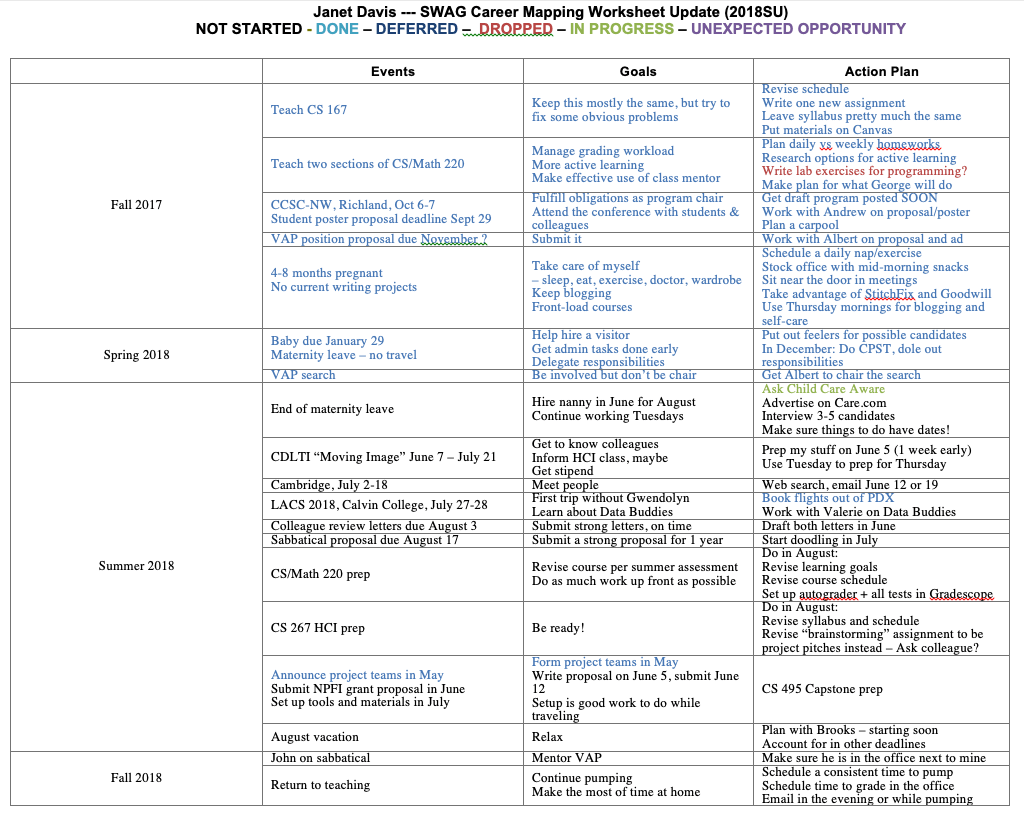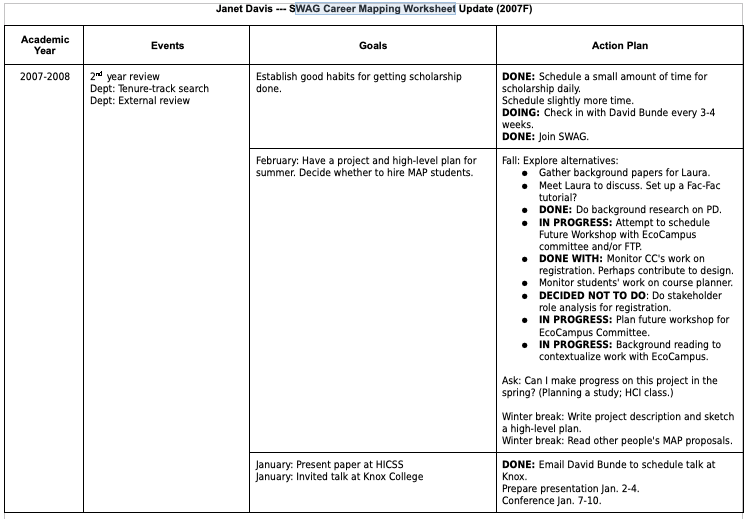Today I rebooted my mid-range career plan, on the timescale of about one month to two years out. To my surprise, I found myself using Trello. How did that happen? Read on.
While I’m an avid user of OmniFocus and Google Calendar for daily and weekly planning – and my students will testify to my well-developed syllabi – I’ve never been much of a long-term planner. In fact, I’ve never had anything like a five-year plan, and it never ceases to amaze me that other people do. Like my colleague and mentor Henry Walker at Grinnell, I’m more of an opportunist.
But when I was in my second or third year at Grinnell, I joined SWAG – either “Scholarly Women At Grinnell ” or “Scholarly Women’s Accountability Group” depending on who you ask. I received a Word document with the title “SWAG Career Mapping Worksheet.” The document consisted of a table with four columns: Academic Year, Events, Goals, and Action Plan. For my first SWAG meeting, I obediently filled it out:
This was pretty useful. One concrete outcome: The next page includes a plan to submit a proposal for the Harris Fellowship, Grinnell’s competitive pre-tenure research leave program. I submitted the proposal as planned, and I was awarded the fellowship.
In fact, the career planning worksheet was so useful that I continued updating my plan after leaving Grinnell for Whitman, even though I had no one in particular to give me feedback and hold me accountable. (Karla, Shannon, Carolyn, Deborah – I still miss you!)
But note that I filled up a whole page and got only halfway through the academic year.
By the last time I used the SWAG Career Mapping Worksheet, more than ten years later, it looked like this: 
I’m pretty sure I got the color-coding idea from Karla. But breaking the year down into Fall, Spring, and Summer – that was something I needed. (It looks like I also made the font smaller to fit more on one page.)
For about ten years, I updated my SWAG plan at least twice a year, and sometimes as many as four times. But the last time I updated it was over a year ago.
What happened? Baby. The last update was at the start of the summer that ended my maternity leave. My scholarly goals were appropriately tiny: my sabbatical proposal and a small grant proposal to a private foundation (shout out to Allen Tucker and the Non-Profit FOSS Institute).
During the last academic year, I focused on teaching, administration, and family. My scholarship was minimal: Since there was a student who wanted to work with me, I wrote a proposal for summer research. And Sam Rebelsky and I finally wrote/presented our SIGCSE paper on the software development course that was my previous sabbatical project at Grinnell. (Which, much to our surprise and amusement, was awarded “Second Best Paper: Experience Reports & Tools”).
I normally would have updated my plan in January before starting the spring semester. But January was wild. I was preparing to teach an overload and graduate our first class. It was a semester with very little professional freedom of movement. I knew everything that needed to get done up to Commencement, and it was impossible to think in any detail beyond that.
Because my summer research student, Buyaki, studied abroad in the spring, she was not available to start until three weeks after Commencement. I had planned to use those three weeks to regroup – to process the spring semester, to pack up teaching materials for my colleagues, and to plan for the coming year. But the day after final grades were due, my family had to abruptly cut ties with our nanny. Caring for my daughter in the aftermath absorbed most of what remained of those three weeks. So much to my discomfort, I started my sabbatical without a written plan. When Buyaki arrived, I just jumped in and started doing things, both with her and on my own.
It may be just as well I didn’t have a plan. Without a plan, I let an exciting new idea run away with me, because I couldn’t think what else I should be doing. More on that in a future post.
Which brings me to now. I’m getting ready to leave on a six-week trip abroad. There is some work I want to get done while I’m traveling, and I’ve arranged for four weeks of part-time child care so I can do it. Working part-time is really different from working full-time, so I don’t want to have unrealistic expectations of myself. Moreover, I can’t bring my whole office with me, so I need to have some idea what to pack up and bring along. But it’s impossible to think about my goals for those next six weeks without thinking about the work I’m deferring until after I return.
In short, I need a plan.
So this morning I pulled up a new copy of the SWAG Career Mapping Worksheet. But it was too daunting. It’s completely out of date – the last row was Spring 2019, which already in the can. And my head was so full I hardly knew where to start. Plus, formatting tables in Word is really tedious. Too much overhead.
I read Amy Ko’s recent essay on managing overcommitment in academia, in which she writes about maintaining a calendar of all her commitments. She includes a picture of her amazing whiteboard. I love my whiteboard, but it’s not so great for consulting while traveling.
My husband and I have talked about our crazy elaborate travel plans for this year, and we’ve been putting them all on our shared electronic calendar. But it’s hard to see everything at once. So he brought home a huge paper calendar that shows the whole year on one piece of paper. Awesome, but also not so great for traveling.
I love using my whiteboard for class planning – in fact, I should put that on my list of topics for future blog posts. But when I’ve needed to plan classes while traveling, or in collaboration with a colleague, I’ve turned to Trello as the next best thing.
As I understand it, Trello was inspired by the adoption of Kanban-style project management by agile software development teams. Tasks are represented as cards, and move from a backlog, to a column of tasks planned for the current iteration, to those that are in progress, and finally done. GitHub now offers a similar project management tool – project boards.
Mid-range planning with Trello felt really natural. I created lists for the time periods that made sense to me, and added cards for events and goals. I made a list on the far left for the things that get done, and put a couple things on it. I also shared it with my husband, because our goals and events affect each other.
Here’s what that looks like:
I can see that I might have too much planned for October – November. Some of those things with question marks might have to go.
What’s lost?
- It’s not so obvious how to associate goals with events.
- While the cards provide space to think through an action plan, in the form of a description or checklist, there’s nothing forcing me to fill that out or making it visible.
- The record of what I’ve done is not going to look the same. Trello allows for colored labels, but I haven’t figured out whether or how I’m going to use them yet.
- Spellchecking is something I can do without.
What’s gained?
- It has much less friction than a table in Word.
- It’s easy to move things around, which suggests some more flexibility in commitments to myself. (Actually, that could be bad.)
- It seems easier to have goals that are amongst the events and not related to any particular event.
- There’s some chance I might look at it and even update it more often than once a quarter. (I always printed out my SWAG plan. In a good semester, I updated it with a pencil as I got things done. In a bad semester, it was ignored until the next SWAG meeting.)
- It’s designed for sharing. Cards can be assigned to individuals, and it’s easy to hide the cards that aren’t assigned to you, so potentially my husband and I could use it for a shared plan.
Enough planning and enough musing. It’s time to pack up my bags and go.


